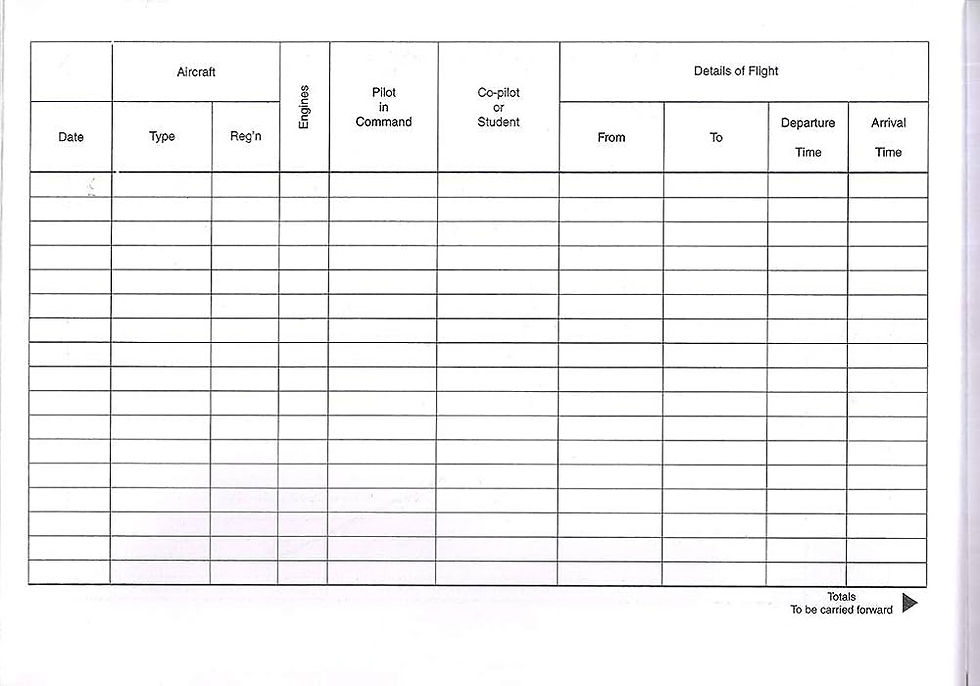How to Fill Out a Pilot Logbook Correctly: A Simple Step-by-Step Guide for New Pilots
- Wingman Log

- Aug 7
- 4 min read

If you're starting your journey to become a commercial pilot (CPL), one of the most important habits you need is to log your flight hours correctly. Your pilot logbook is not just a diary, it’s your proof that you’ve done the flights needed to get your license.
Whether you're training in India, the US, Europe, the Middle East, or anywhere else, this guide will help you understand how to fill your logbook the right way , step by step.
Why Is the Pilot Logbook So Important?
Your logbook is the official record of:
All the hours you've flown
The types of flights you’ve done (solo, night, cross-country, etc.)
The aircraft you've flown
Your role in each flight (student, co-pilot, PIC)
It’s required when:
Applying for your CPL or ATPL
Converting a foreign license
Attending airline interviews
Renewing your license or ratings
If you’re training in India, check this helpful guide on CPL flying requirements.
If you're converting a foreign CPL to Indian, here’s the foreign license conversion process.
Step-by-Step: How to Fill Out a Pilot Logbook
Step 1: Include the Right Fields
Every country’s aviation authority expects a few key things in your logbook. The layout may look different, but most include:
Date of flight
Aircraft type & registration (e.g., A320, VT-ABC)
From and To airport
Flight duration (in HH:MM format)
Your role (student, co-pilot, solo, etc.)
Day or night flight
Cross-country or not
Instrument time (if any)
Simulator time (if any)
Instructor’s remarks or sign-off
Wingman Pilot Logbook helps you with all these fields and makes sure you don’t miss anything.

Step 2: Record Time in the Correct Format
Use HH:MM format (e.g., 01:45, not 1.75).Make sure you’re clear about:
Block Time – From when brakes are released at departure to when brakes are set after landing (used by most airlines).
Airborne Time – From takeoff to landing (used in some flight schools).
Simulator Time – Only log this if it’s on an approved device.
Step 3: Log the Correct Role
Always mention what role you played in the flight:
Student / Dual – When flying with your instructor
Solo – When flying alone
PIC (Pilot in Command) – Only after you are licensed and fully responsible
SIC / Co-pilot – When flying as second-in-command
PICUS – Logged under instructor supervision (used in EASA and some airline programs)
⚠️ Don’t log PIC time if you haven’t earned it — it may cause problems during license checks.

Step 4: Separate Special Time
Some flights are more important for your license. Track these carefully:
Night Flying – Only the time after sunset, before sunrise
Cross-Country – Flights over a set distance (like 50 NM in FAA rules)
Instrument Time – Time spent flying only using instruments, either in clouds (IMC) or under a hood
Simulator Time – Only if approved by your school or authority
Need help understanding how many hours are needed? See this CPL flight experience guide.
Step 5: Save Documents That Prove Your Flights
You may need to show:
Instructor signoffs
SIM certificates
Rosters or schedules
Flight briefings
Written exam reports
In Wingman Pilot Logbook, you can attach these documents to each logbook entry , so you never lose them.
Step 6: Export Your Logbook in the Right Format
Before your CPL checkride or license application, your logbook must be:
Printed or exported in the format required by your aviation authority (FAA, DGCA, EASA, etc.)
Signed by your instructor or training head
Well organized, with total hours neatly shown
Wingman makes this easy. Just choose your authority and generate a ready-to-submit report in one click.
Common Mistakes New Pilots Make
Logging PIC without proper qualification
Forgetting to get instructor signoff
Using decimal time format (e.g., 1.5 instead of 01:30)
Not tracking cross-country distances
Skipping simulator or instrument time
Paper vs. Digital Logbook: Which One Is Better?
Feature | Paper Logbook | Digital Logbook |
Easy to update | ❌ | ✅ |
Automatically adds totals | ❌ | ✅ |
Supports attachments (rosters, signoffs) | ❌ | ✅ |
Accepted by regulators | ✅ | ✅ |
Format for DGCA/FAA/EASA | ❌ | ✅ |
Why Wingman Pilot Logbook Is Best for CPL Students
Wingman Pilot Logbook is built for pilots with their career in mind. It helps you:
Log flights correctly from day one
Automatically separate night, solo, SIM, cross-country time
Attach documents and rosters
Export logbooks in the right format (DGCA, FAA, GCAA, etc.)
Whether you're training in the USA, UAE, India, or Europe, Wingman Pilot Logbook keeps your hours accurate and your license application ready.
Final Thoughts
Your CPL is a big milestone. And your logbook is the key to getting there.
Start building the habit of logging flights correctly from day one. Use a format your regulator accepts. Get the right signoffs. And never lose your data.
The smarter you log, the faster you'll fly.
FAQs: New Pilot Logbook Tips
1. Can I use a digital logbook for my CPL?
Yes. Most countries allow digital logbooks. Just make sure they’re in the right format when printed. Wingman supports this.
2. How do I know how many hours I need?
It depends on your country. If you are in India, check this guide to CPL flight hours in India or ask your flight school.
3. What’s the difference between solo and PIC?
Solo is when you're the only person in the airplane. PIC is pilot-in-command, which means you're legally responsible, usually after you’re licensed.
4. Can I log SIM time in my total hours?
You can log it separately, but it usually doesn't count toward your total flight time. It is counted only if approved.




Comments